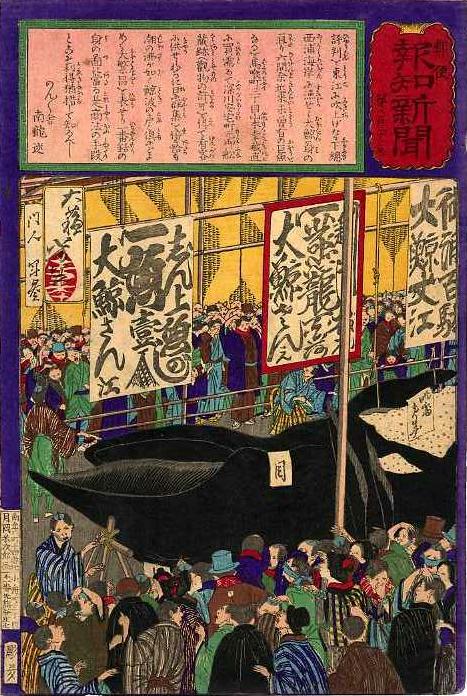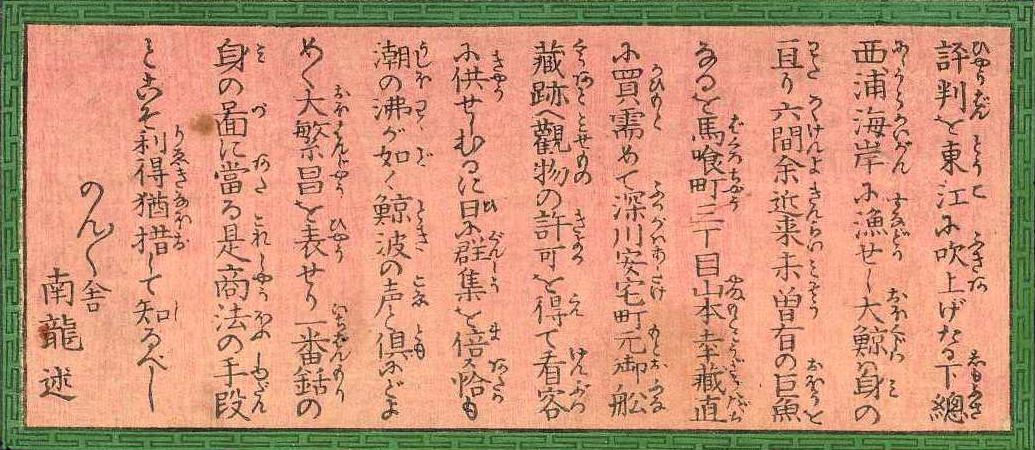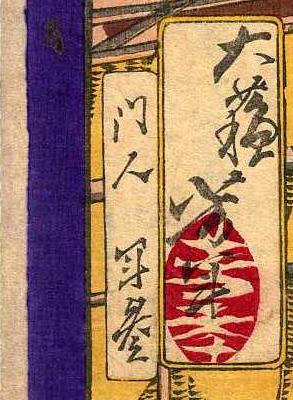Transcription and translationThe story in the pink cartouche is attributed to Nonnonsha Nanryū (のんのん者南龍), the pen name of a writer who has not been identified.
The story transcribes and translates as follows. The transcription and structural translation are mine. I have shown phonetic furigana in (parentheses) following kanji. Hentaigana are shown in standard kana representing the orthography used on the print.
|
CommentaryThe whale -- about 12 meters long -- was tugged up the Sumida river to a former government boathouse in Fukagawa Atakechō, where it attracted huge crowds of spectators -- and made some people a lot of money. Bakurochō was on the other side of the river. Shimofusa . . . has spouted its reputationThe story leads with wordplay -- for the term with which Shimofusa (下総) is said to have "spouted" or "blown" its reputation (評判を吹上げる hyōban o fukiageru) is the same as that used to say that a whale "spouts" or "blows" the sea (潮を吹き上げる ushio wo fukiageru). The setting of the whale exhibition was a former government boathouse on the Sumidagawa (隅田川), a river that runs through Tokyo and spills into Tokyo bay. The river in the expression "east river" (東江 touko > toukou > tōkō) was most like the Edogawa (江戸川), which is east of the Sumidagawa and defines the border between Tokyo and Chiba prefectures. The Edogawa separates present-day Ichikawa city in Chiba prefecture from Edogawa ward in Tokyo as it spills into Tokyo bay. This area was formerly part of the province of Shimofusa, ruled from Kōnodai castle (国府台城), which stood, as its name implies, on the rise (台 dai) of the provincial headquarters (国府 kokufu). The site of the castle, along the east bank of the Edo river, is now an historical park in the Kōnodai district of Ichikawa. During the 16th century, the castle was the site of some major battles as powerful warlords jockeyed for control of the eastern provinces around the village of Edo -- where the Tokugawa clan established its castle and government in 1603, when the dust had settled on battlefields throughout Japan. Most of Shimofusa province (下総国 Shimofusa no kuni) was in the northern part of present-day Chiba prefecture, and adjacent parts of Tokyo, Saitama, and Ibaraki prefectures. It included villages and towns that are now part of the cities of Ichikawa, Funabashi, Chiba, Kashiwa, Yachiyo, Matsudo, Noda, Narita, and Choshi among others in Chiba prefecture, parts of Katsushika-ku and Edogawa-ku in Tokyo, Misato and Satte cities in Saitama, and Koga city in Ibaraki. Local remnants of the name today may be pronounced and written Shimōsa (しもうさ Shimousa) -- which represents a phonetic shift from "fu" to "u" and a reduction of "o + u" to "ou" or "ō". In more remote days the name was "Shimo-tsu-fusa" -- the "tsu" a genitive like "no". The counterpart was "Kami-tsu-fusa" (上総) -- later reduced to "Kadzusa" (かづさ), today Kazusa (かずさ) in reference to localities now in central Chiba prefecture. I amuse people who asked where I am from by saying "Shimofusa" -- as my home is in a town that is part of what used to be in the Sōma district of Shimofusa province, and Minami Shimofusa when the district was split in the early Meiji years. My neighborhood, though very quiet, happens to be on the flight path for patrol planes returning to Shimofusa Air Base, a Japan Maritime Self-Defense Force facility a bit to the south. The windows of my study face north, hence toward incoming aircraft, which have already leveled off and lost considerable altitute by the time they pass directly over my roof -- so close, at times, I feel the cockpit crew can see me typing. The planes -- mostly twin-engine propeller craft -- at times come in at such an angle to the crosswinds they appear to be flying sideways. great whalefishThe story calls the beast a "great whale" (大鯨 ohokujira > ookujira > ōkujira). It is also called a "huge fish" (巨魚 ohouwo > oouo > ōuo). The classical name for such a "fish" was "ōisana" (大鯨魚 oho) -- or "great whalefish". Isana is also written 勇魚, as in Isana, "the joint publication of the Japan Fisheries Association and the Japan Whaling Association". The English section of JWA's homepage says this about the meaning of the word (from JWA's website on 10 February 2008).
whale huntingThe great whale is said to have been "caught" (漁せし sunadori seshi > sunadori shita) -- literally "taking" (tori) from "sand" (suna") from the verb "sunadoru". The classical verb for gathering shellfish -- and metaphorically hunting and gathering any food -- was "asaru" and "isaru". The classical word for whale hunting was "isanatori" (鯨魚). The website of the Consulate-General of Japan in Sydney, in explaining Japan's stance regarding the whaling issue, observes that the phrase「鯨魚 (いさな) とり」(isanatori) appears in 12 songs in the 「万葉集」(Man'yōshū), Japan's oldest anthology of poetry. The Man'yoshu, compiled during the 8th century, includes over 4,200 short poems, nearly 300 long poems, and a few Chinese poems and essays. The magestic whale fish is graphically represented several ways, typically in the five-mora phrase "usanatori" meaning whale taking, whale hunting, or just whaling. The phrase was commonly used as a "makurakotoba" or "pillow word" with umi (sea), ura (bay), hama (beach), and nada (ocean) -- as in this waka (my translation).
Fukagawa Atakecho and former boathouseFukagawa Atakechō (深川安宅町) became part of Fukagawa-ku, in Tokyo, under the 15-ku system created in 1878. It is now part of the Shin'oohashi (Shin'ōhashi) area of present-day Koto-ku (江東区 Kōtō-ku). Koto-ku, so named because it is east of the Sumida river, was created in 1947 as part of the 23-ku system, from Fukagawa-ku and Joto-ku (城東区), which had been created in 1932 under the 35-ku system. Atakecho took its name from Atake-maru (安宅丸), the flagship (御座船 gozabune) of the third shogun Tokugawa Iemitsu (徳川家光 1604-1651). His ship, its hull sheathed by copper plates, and other vessels in the Tokugawa navy, were moored along that stretch of the Sumida river. At one time there were as many as fourteen boathouses in the area. The river at that point has been bridged by Shin'oohashi since 1693. The bridge has been rebuilt many times. The present bridge, constructed in 2005, crosses the river from Nihonbashi Hamacho in Chuo-ku on the west bank, to Shin'oohashi in Koto-ku on the east bank. Older wooden versions of the bridge are well known in woodblock prints. The Shin'oohashi area embraces Morishita station on the Shinjuku and Oedo subway lines today. Bakurochō (馬喰町) was soon (in 1878) to become part of Nihonbashi-ku, now (since 1947) part of Chuo-ku, on the west side of the Sumida river. The Bakurocho area of Nihonbashi is served by Bakurocho-Yokoyama station on the Shinjuku line, Bakurocho station on the JR Sobu line, and Higashi-Nihonbashi station on the Asakusa line. Anyone living in the area at the time of the Shimofusa whale exhibit would recognize most of the station names but be totally lost in the tangle of subways and the maze of pavement, steel, concrete, and glass on the surface. the cries of a whale waveThe "cries of a whale wave" (鯨波の声 toki no kowe > toki no koe) was a metaphor for a wave of cries such as those that were raised in unison by armies about to charge each other in battle. The word "toki" is classically graphed 鬨 for its meaning and sometimes 時 for its sound. The graph 鬨 means the noise, clamour, uproar, or din of a battle or fight, and is found in expressions like "kachidoki" (勝鬨) -- a "victory cry" or "shout of triumph". The compounds 鯨波 and 鯨浪, read "geiha" and "geirō" in Sino-Japanese, may by themselves convey the meaning of a giant, whalelike wave of voices -- such as those raised in a war whoop. Here, 鯨波 is a graphic metaphor for -- a "characterization" if you will -- of the crowd's excitement -- of cries which reverberated in a manner reminiscent of the roar of the sea in which the whale had lived and been caught. the first harpoon . . . to hit the markThe "first harpoon" (一番銛 ichiban mori) to strike a whale is the hunting equivalent of the "first spear" (一番槍 ichiban yari) to be thrown at the enemy at the start of a battle. To "hit the mark" (図に当たる zu ni ataru) is a metaphor for "go as planned" or "succeed" in some matter -- a hunt, battle, or business venture. The whale appears to have made money for a lot of people -- from its hunters and exhibitor, to the people who sold its meat, blubber, and bones -- and the multifarious merchants, vendors, hawkers, and hustlers who stand to profit from throngs of people in any established or spontaneous marketplace -- not to forget the producers and sellers of this woodblock print. |
|||||||
SerendipityOne of the pleasures of exploring social history is to behold artifacts with an ear, ear, nose, touch, taste, and heart for the people who produced and used them. History is nothing without the lives of those who made things to satisfy one or another need or desire -- things which, by chance more than design, have survived the times and elements, and wait to be discovered. To discover something is to learn about something for the first time. Discovery therefore requires ignorance -- a state of not knowing something -- including lack of knowledge resulting from having forgotten or lost something. I am constanting discovering my glasses on my face, while looking for them, thinking I had taken them off and left them somewhere. This is a metaphor for history. Entire societies rediscover pasts that have slipped into the caves of collective forgetfullness and loss of memory. First learningI first learned of the existence of the Shimofusa whale print in the table at the back of Tsuchiya 1995. It is also listed in a similar but updated table on Tsuchiya 2000, with a note that the compilers were unable to obtain an image of the print for inclusion on the CD-ROM. First web sightingI first saw an image of the print on 30 September 2004, on the website of Nikkodo Shoten, a bookshop in Nagoya which also deals in woodblock prints and other curios. I query to the dealer brought a reply to the effect that the print had recently been sold. Fortunately, though, I was able to capture a small image of the entire print, and a scan of the publication disclosures. The images and their description continued to be posted on Nikkodo as late as February 2008. By January 2010 they had disappeared. First book sightingI first saw a black-and-white image of the print in van den Ing and Schaap 1992 (page 114), which very briefly described the print, following Keyes doctoral dissertation (1982:407, item 315.58). The 1992 exhibition catalog noted that the print had been a gift from Sidney A. Tannenbaum to the Philadelphia Museum of Art. I later saw a black-and-white image in Segi 1985 (page 49), an English publication (Kodansha International), which shows but does not describe or attribute the print. This publication was largely inspired by Segi 1978 (Kodansha), which does not show the print. I suspect the source of the Segi 1985 image is van den Ing and Schaap 1992. First catalog sighting and purchaseI first spotted a copy of the Shimofusa whale print for sale in a Yamada Shoten catalog that arrived on the afternoon of 27 July 2008. I immediately faxed and emailed the store to reserve this and another print for me if they had not been sold. Around noon the following day I received an email informing me that both prints were still available and would be held for me. When I picked up the prints, the following week, I asked the two women who handled the purchase if they knew the basis for the pricing of the whale print. They did not, and the owner of the shop, the father of one of the women, who would have known, was out. Kanda prices of prints in the YHS series somewhat vary, but not greatly. I generally find that dealers are not especially interested in news nishikie, and base their pricing more on the popularity of the genre and the drawer. Yamada Shoten had a copy of the book related to the exhibition, mounted by the Chiba City Museum of Art from 12 January to 2 March 2008, of a private collection of the TNS and YHS news nishikie series. CCMA, which edited the book, claimed that the exhibition and the book included all prints in the series -- all but a few from the private collection, the others borrowed from some institutions, including the National Diet Library. The whale print cost me nearly twice what I had ordinarily paid for a YHS print which was solid, was of good impression, and had been well protected from moisture and light. It is not clear that the absence of any mention of the print in CCMA 2008 figured in Yamada's pricing. My guess would be that its price was higher because of its theme -- whale prints being in high demand, and this particular whale print being so striking. I considered it worth much more than I had paid. Unrivaled rivalA few weeks later I learned from the person who owns the private collection of TNS and YHS prints exhibited at the CCMA that he, too, had seen the whale print in the Yamada catalog and immediately called -- but was told he was too late. I had become acquainted with him in 2007, the year before the exhibit. He invited me to an exhibition being held that year and met me at the museum. After lunch, he introduced me to the director of the museum, who was then in the process of mounting the TNS and YHS exhibition. In 2009, when meeting the collector at another museum, I showed him the original of the whale print and gave him a copy I had printed from a high resolution scan. I felt a bit guilty, but then I had mediated a purchase of a triptych in the TNS series which he did not yet have. In some sense, concerning the TNS and YHS prints, the collector and I are rivals. But he is clearly my dai senpai. And there is no rivalry in our sharing of information about news nishikie. He has been collecting for several decades to my half dozen years. While he too focuses on early Meiji prints, the scope of his collection is far broader than mine, and his interest in woodblock printing run considerably deeper. Needless to say, the flow of information has been all but one way. And every conversation with him has been, for me, a reminder of how much more there is to know that I will never know. |
|||||||
Principal sources
The most influential English sources concerning the KIKS series are Keyes 1982 and van der Ing and Schaap 1992. Japanese sources with images of some of the prints include Konishi 1977 and Akita 1999.
For reviews of these and other secondary sources referred to on this page, see the Bibliography section of this website.
For more information about Toshimitsu and Nonnonsha, see the articles on the stages of the YHS series, but especially YHS news nishikie: Seals and Toshimitsu.



